Dried Rice Noodles 101
Dried rice noodles, also known as rice sticks in English and pai mi fen in Mandarin, are available in nearly any Asian market, and in many American grocery stores in either the international foods sections or the health food aisle. Widely used in China, Thailand, Vietnam, Singapore and Indonesia, dried rice noodles come in a myriad of sizes and shapes.
From the nearly hair-fine crinkly strands of rice vermicelli illustrated above to flat fettuccine-shaped noodles a half-inch wide, these translucent, brittle dried noodles can be used in a variety of dishes, including cold salads, stir fries and soups. Depending on the cooking method, the texture of these noodles can be tender or chewy, slippery or firm, but they are always smooth and satisfying.
Their own inherent flavor is mild, so rice noodles make the perfect canvas for a nearly endless variety of sauces, broths, and condiments. They are equally at home in dishes mild and comforting as they are supporting a cast of fiery and flavorful ingredients.
Rice noodles are among the most versatile standards of the Chinese pantry, which is wonderful, because they are also astoundingly inexpensive. Only a dollar or so per pound, dried rice noodles are an easy way to feed a whole houseful of family and friends cheaply.
There are many brands on the market, not all of them Chinese in origin. That doesn’t really matter–rice noodles are rice noodles, whether they are made in Vietnam and labeled banh pho or Thailand where they are called kui teow. What matters is that you choose a shape and size that works with your recipe, and then treat them properly before you cook with them.
The best dried rice noodles are made only of rice and water. These will have the best texture; the ones which have cornstarch or other starches added are of inferior quality, and will be more likely to have a mushy texture when cooked. They are, in my opinion, not worth the money you pay for them.
Before cooking rice noodles, they must be soaked in water to soften them. Even if you are planning on boiling the noodles or serving them in soup, they must be soaked to the proper texture before you attempt to cook them. For wide or thick noodles, very hot to boiling water is used to soak them; for very thin or rice vermicelli, use warm to cold water. The length of time you have to soak the noodles will depend on how warm the water is; the hotter the water, the less time it takes for them to soak. (However, remember, if you use boiling water on rice vermicelli to soak it–you may wind up overcooking the very thin, fine noodles instead of soaking them to the proper texture–so be forewarned!)
What exactly is the proper texture for soaked rice noodles? Well, it is easiest to refer to the photographs above and below this paragraph. The one above shows noodles that are not finished soaking–they are softened, and they have turned from translucent to white, but as you can see, they are still somewhat stiff and only slightly pliable. If you were to try and use these noodles in a stir fry as they are now, they would be tough, chewy and overly crisped on the edges, and would not be very appealing at all. In a soup, they would be equally unpalatable, as they would lack smoothness and tenderness. If you attempted to boil them to the proper texture, it is likely that you may overcook them, as rice noodles can go from perfection to mush within a split second. In order to shorten the boiling process down to a bare minute or less, it is best to soften the noodles completely before cooking them.
In the photograph below, you see rice noodles which have soaked the proper amount of time. They are fully softened to easy pliability, they drape gracefully from the hand like pale ribbons. At this stage, it will only take a minute’s worth of a dunk in a pot of boiling water or a good tossing in a wok of hot oil to finish the cooking process.
In order to soak them, it helps to have a large bowl where the noodles can spread out and have plenty of room. Just cover the noodles with hot or cold water, as needed and make certain every noodle is completely under the water. Swish them around now and again to separate them and to test their readiness.
To boil rice noodles to be used in soups or in cold noodle dishes, soak them until they are soft, and then drain them. Bring water in a large pot to a boil, and drop the noodles in. Start timing the noodles, and cook for no more than a minute. I usually remove them as soon as the water comes back to the boil. Check for doneness–they should be soft and pliant without being mushy.
Then drain and rinse in cold water. For cold noodle dishes, toss immediately with the dressing after being rinsed, for soup noodles, warm them immediately in boiling soup after rinsing. Rinsing removes extra starch from the surface of the noodles and keeps them from being a bit gummy.
For noodles destined to be stir-fried, the noodles only need to be soaked. If they feel starchy when they are finished soaking, they can be rinsed before draining them. I usually drain them for at least ten minutes before they are due to hop into the wok to get most of the water off of them, but if I lack that amount of time, I have been known to pat them dry with paper towels. They do not need to be perfectly dry, however, because a little bit of water clinging to them helps steam them a bit as they go into the wok, which helps cook them further, resulting in a more tender yet chewy noodle.
While I am very fond of rice noodles in both soups (the ubiquitous Vietnamese pho being an obvious example) and as cold noodles, my favorite dishes with them are stir-fried. Unfortunately, many restaurants use more oil than is absolutely necessary to get a good result with stir fried rice noodles, so many have the mistaken notion that fried rice noodles must just by necessity be greasy. This is not the case, as I hope to illustrate over the next few posts.
Before we are finished discussing the basics of dried rice noodles, I have to mention that a classic way of serving rice vermicelli is as a crispy garnish or appetizer, deep fried. To fry them, the noodles need only be separated while dry, and then dropped into a wok filled with hot oil. There, they puff up dramatically into snowy-white crispy nests. These are used as garnishes atop stir fries, or as a bed for a spicy stir fry or are mixed into a dry fried beef dish which is eaten as an appetizer in Sichuan province wrapped in lettuce leaves.
Those are the basics about dried rice noodles. Fresh rice noodles are another topic altogether, which I will treat at length in a later article. For now, I hope your appetite is whetted for the rice noodle recipes to come.
15 Comments
RSS feed for comments on this post.
Sorry, the comment form is closed at this time.
Powered by WordPress. Graphics by Zak Kramer.
Design update by Daniel Trout.
Entries and comments feeds.

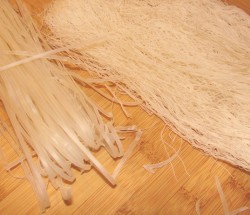
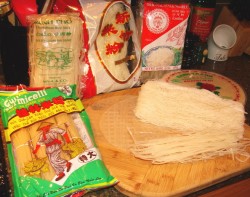
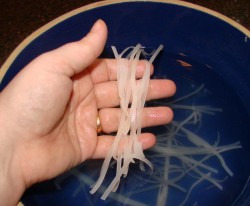
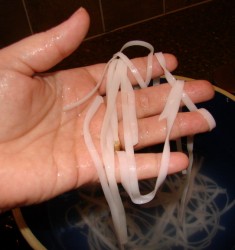
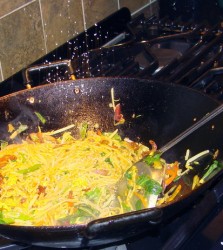


Many thanks for that info. I always end up with over cooked noodles. This info has appraised my knowledge
Comment by Lakshmi — August 28, 2007 #
Many thanks for that info. I always end up with over cooked noodles. This info has appraised my knowledge
Comment by Lakshmi — August 28, 2007 #
These noodle articles are awesome! Must agree with you on the fried noodles, though Pho is good, too. I am eager to see the recipes. Thanks.
Comment by Adam Ziegler — August 28, 2007 #
I love stir fried noodles! I have a recipe from Fine Cooking that I’ve made a few times, as recently as last week! So good and easy. I learned through trial and error the way to get the noodles cooked properly. But now…Mmmmm!
Here’s my recent post on the stir fried noodle:
http://sseichinger.blogspot.com/2007/08/fast-and-delish.html
Comment by scotte — August 28, 2007 #
Wonderful article!
Comment by serene — August 28, 2007 #
Your writing is just fantastic – graceful yet conveying a great deal of information. Really useful information!
Looking forward to your fresh rice noodle post a great deal.
Comment by Zoe — August 29, 2007 #
I use rice needles quite often but I never knew that one should soak them even before boiling. I’ll try this next time I cook some and see what difference it makes. Thanks for the informative post, Barbara.
Comment by Trig — August 30, 2007 #
Thanks so much for the detailed information. Others gave lots of recipes but not just what to do to cook the noodles. I have had these in my cubbard for a while and look forward to enjoying them now. I wonder why they do not tell you how to cook them on the package? Thanks again.
Bonnie
Comment by Bonnie — August 31, 2007 #
Incredibly helpful and nicely written! Thanks so much for a fabulous resource!
Comment by Sara — January 11, 2008 #
Bless you! After a lifetime of overcooking fine rice noodles you’ve shown me how to get it right! I’m off to make a rice nooble salad immediately.
Go well
Elisabeth
Comment by Elisabeth — February 10, 2008 #
Bless you! After a lifetime of overcooking fine rice noodles you’ve shown me how to get it right! I’m off to make a rice nooble salad immediately.
Go well
Elisabeth
Comment by Elisabeth — February 10, 2008 #
Great article, prior to reading this I attempted to cook rice noodles for my first time the other day, needless to say, they were WAY too soft and stuck together. Now I know you don’t need to boil them for a lengthy time like you would a grain noodle!
Comment by Cody — September 28, 2008 #
Thank you very much for taking the mystery out of preparing rice noodles.
The pictures made an already excellent post even better.
I’ve got some soaking now.
Cheers
Comment by Kim — November 19, 2008 #
[…] Cook the rice noodles according to directions. Be careful not to overcook. After they are done, run under cold water to stop the cooking process. I absolutely recommend the rice noodles. You can find a 101 on them here. […]
Pingback by Asian Beef and Noodle Soup – So Delish! « hazel eyed betty — March 15, 2011 #
Thank you … I feel more empowered to test your theory I didn’t know there was such a technical aspect … All I really wanted to know what it was my nana had given me to cook. With this info I no only know but will succeed as I prepare my stirfry informed
Comment by May tag miller — June 7, 2012 #